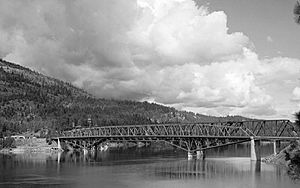Kettle Falls Bridges facts for kids
Quick facts for kids Kettle Falls Bridges |
|
|---|---|
 |
|
| Coordinates | 48°37′33″N 118°07′00″W / 48.62573°N 118.1168°W |
| Carries | Kettle Falls International Railway (north bridge) |
| Crosses | Columbia River |
| Locale | Kettle Falls, Washington |
| Characteristics | |
| Design | Steel cantilever |
| History | |
| Opened | May 3, 1941 |
|
Columbia River Bridge at Kettle Falls
|
|
| Area | less than one acre |
| Architectural style | Steel Through Truss |
| MPS | Bridges of Washington State MPS |
| NRHP reference No. | 95000260 |
| Added to NRHP | March 28, 1995 |
The Kettle Falls Bridges are two cool bridges that cross the Columbia River near Kettle Falls, Washington. One bridge is for cars and trucks, carrying U.S. Route 395 and State Route 20. The other bridge, which looks very similar, is for trains on the Kettle Falls International Railway. Both bridges are made of steel and are called "cantilever" bridges because of how they are built.
Building the Kettle Falls Bridges
The road bridge at Kettle Falls opened on May 3, 1941. Both bridges were built for an important reason. They replaced older bridges that would soon be underwater. This happened because the Grand Coulee Dam was built. The dam caused the water level to rise, forming a new lake called Franklin D. Roosevelt Lake.
These bridges are historically important. They have the longest central spans of any highway bridge built in Washington state during the 1940s. In 1995, the road bridge was added to the National Register of Historic Places. This means it's a special place recognized for its history.
The Road Bridge Design
The road bridge is very long, measuring about 1,266 feet (386 meters). It was finished in 1941. This new bridge replaced an older one from 1929. The old bridge's location was going to be partly covered by Lake Roosevelt. This lake formed behind the new Grand Coulee Dam.
At first, this bridge carried Primary State Highway 3. Later, it became part of U.S. Route 395. The bridge is mainly a steel cantilever bridge. This type of bridge uses strong beams that stick out from piers. Its design helped reduce the height of the concrete piers.
The main part of the bridge is 300 feet (91 meters) long. The parts that stick out, called cantilevered spans, are 150 feet (46 meters) long each. This makes the total span between the main piers 600 feet (183 meters). The bridge also has smaller sections called anchor spans, which are 225 feet (69 meters) long. There are also approach spans, which are the parts leading up to the main bridge.
This two-lane bridge was the longest of its kind built in Washington between 1941 and 1950. The Washington Department of Highways designed it. R.W. Finke was the designer. The L. Romano Engineering Company in Seattle built the parts. The U.S. Bureau of Reclamation paid for the project. This was part of the bigger Grand Coulee Dam project.
Originally, there was a plan for just one bridge. It would carry both the highway and the Great Northern Railroad. The railroad also needed to move its tracks. But they couldn't agree on a shared contract. So, a separate, similar-looking bridge was built right next to it for the trains.
The Kettle Falls bridge looks similar to the Grand Coulee Bridge, built in 1935. However, the Kettle Falls bridge has a nicer look. Its design was also used for the larger Northport Bridge in 1948. The bridge officially opened on May 3, 1941. The old bridge was taken apart that summer.
The Kettle Falls road bridge was officially listed on the National Register of Historic Places on March 28, 1995.


